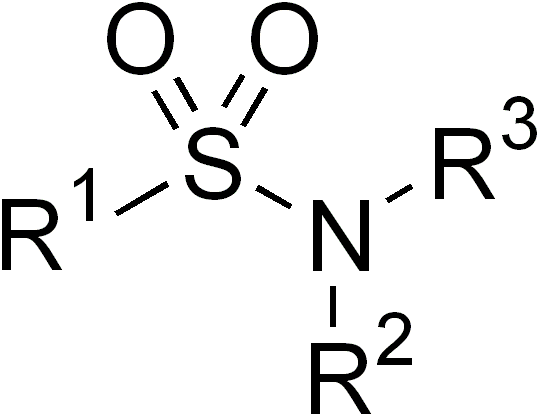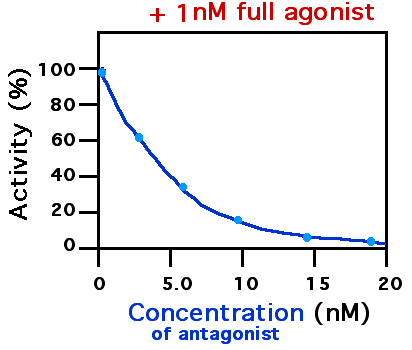|
NBQX
NBQX (2,3-dioxo-6-nitro-7-sulfamoyl-benzo uinoxaline) is an antagonist of the AMPA receptor. NBQX blocks AMPA receptors in micromolar concentrations (~10–20 μM) and also blocks kainate receptors. In experiments, it is used to counter glutamate excitotoxicity. NBQX was found to have anticonvulsant activity in rodent seizure models.Yamaguchi, S.; Donevan, S.D.; Rogawski, M.A. (1993). Anticonvulsant activity of AMPA/kainate antagonists: comparison of GYKI 52466 and NBOX in maximal electroshock and chemoconvulsant seizure models. ''Epilepsy Res.'' 15:179–184. As the disodium salt, NBQX is soluble in water at high concentrations (at least up to 100 mM). See also *CNQX *DNQX *Fanapanel (MPQX) *Quinoxalinedione Quinoxalinedione is an organic compound with the formula C6H4(NH)2(CO)2. It is a colorless solid that is soluble in polar organic solvents. Quinoxalinediones are a family of related compounds sharing the same bicyclic core. Various quinoxalinedi ... References AMP ... [...More Info...] [...Related Items...] OR: [Wikipedia] [Google] [Baidu] |
Quinoxalinedione
Quinoxalinedione is an organic compound with the formula C6H4(NH)2(CO)2. It is a colorless solid that is soluble in polar organic solvents. Quinoxalinediones are a family of related compounds sharing the same bicyclic core. Various quinoxalinediones are drugs. Synthesis and structure Quinoxalinedione is produced by condensation of dimethyloxalate and o-phenylenediamine: :C2O2(OMe)2 + C6H4(NH2)2 → C6H4(NH)2(CO)2 + 2 MeOH The compound exists in solution and the solid state predominantly as the diamide form. Some reactions of the compound indicate a role for the diol tautomer. Drugs based on quinoxalinediones Quinoxalinediones act as antagonists of the AMPA, kainate, and/or NMDA receptors of the ionotropic glutamate receptor family. Examples include the following: * ACEA-1011 * Becampanel * CNQX * DNQX * Fanapanel (MPQX) * Licostinel (ACEA-1021) * NBQX * PNQX * YM90K * Zonampanel A drug closely related to the quinoxalinediones, but possessing a quinazoline ... [...More Info...] [...Related Items...] OR: [Wikipedia] [Google] [Baidu] |
CNQX
CNQX or cyanquixaline (6-cyano-7-nitroquinoxaline-2,3-dione) is a competitive AMPA/ kainate receptor antagonist. Its chemical formula is C9H4N4O4. CNQX is often used in the retina to block the responses of OFF-bipolar cells for electrophysiology recordings. CNQX is an antagonist of α-Amino-3-hydroxy-5-methyl-4-isoxazolepropionic acid (AMPA)-type glutamate receptors (AMPARs). A study of the effects of CNQX on vestibuloocular reflex adaptation was done on goldfish by injecting CNQX into the vestibulo-cerebullum. The injection before adaptation significantly decreased and at the highest doses, completely inhibited the acquisition of adaptive reflex gain increases and decreases during a three-hour training period. Baseline performance was not affected by the CNQX injections. Injections of CNQX at the end of the training period shows a rapid loss of gained vestibuloocular reflex adaptation when the goldfish remained stationary in the dark. Instead of injecting CNQX immediately afte ... [...More Info...] [...Related Items...] OR: [Wikipedia] [Google] [Baidu] |
AMPA Receptor
The α-amino-3-hydroxy-5-methyl-4-isoxazolepropionic acid receptor (also known as AMPA receptor, AMPAR, or quisqualate receptor) is an ionotropic transmembrane receptor for glutamate (iGluR) that mediates fast synaptic transmission in the central nervous system (CNS). It has been traditionally classified as a non- NMDA-type receptor, along with the kainate receptor. Its name is derived from its ability to be activated by the artificial glutamate analog AMPA. The receptor was first named the "quisqualate receptor" by Watkins and colleagues after a naturally occurring agonist quisqualate and was only later given the label "AMPA receptor" after the selective agonist developed by Tage Honore and colleagues at the Royal Danish School of Pharmacy in Copenhagen. The ''GRIA2''-encoded AMPA receptor ligand binding core (GluA2 LBD) was the first glutamate receptor ion channel domain to be crystallized. Structure and function Subunit composition AMPARs are composed of four types of ... [...More Info...] [...Related Items...] OR: [Wikipedia] [Google] [Baidu] |
Kainate Receptor Antagonists
Kainic acid, or kainate, is an acid that naturally occurs in some seaweed. Kainic acid is a potent neuroexcitatory amino acid agonist that acts by activating receptors for glutamate, the principal excitatory neurotransmitter in the central nervous system. Glutamate is produced by the cell's metabolic processes and there are four major classifications of glutamate receptors: NMDA receptors, AMPA receptors, kainate receptors, and the metabotropic glutamate receptors. Kainic acid is an agonist for kainate receptors, a type of ionotropic glutamate receptor. Kainate receptors likely control a sodium channel that produces excitatory postsynaptic potentials (EPSPs) when glutamate binds. Kainic acid is commonly injected into laboratory animal models to study the effects of experimental ablation. Kainic acid is a direct agonist of the glutamic kainate receptors and large doses of concentrated solutions produce immediate neuronal death by overstimulating neurons to death. Such damage an ... [...More Info...] [...Related Items...] OR: [Wikipedia] [Google] [Baidu] |
Lactams
A lactam is a cyclic amide, formally derived from an amino alkanoic acid. The term is a portmanteau of the words ''lactone'' + ''amide''. Nomenclature Greek prefixes in alphabetical order indicate ring size: * α-Lactam (3-atom rings) * β-Lactam (4-atom rings) * γ-Lactam (5-atom rings) * δ-Lactam (6-atom rings) * ε-Lactam (7-atom rings) This ring-size nomenclature stems from the fact that a hydrolyzed α-Lactam leads to an α-amino acid and a β-Lactam to a β-amino acid, ''etc''. Synthesis General synthetic methods exist for the organic synthesis of lactams. Beckmann rearrangement Lactams form by the acid-catalyzed rearrangement of oximes in the Beckmann rearrangement. Schmidt reaction Lactams form from cyclic ketones and hydrazoic acid in the Schmidt reaction. Cyclization of amino acids Lactams can be formed from cyclisation of amino acids via the coupling between an amine and a carboxylic acid within the same molecule. Lactamization is most efficient in thi ... [...More Info...] [...Related Items...] OR: [Wikipedia] [Google] [Baidu] |
Quinoxalines
A quinoxaline, also called a benzopyrazine, in organic chemistry, is a heterocyclic compound containing a ring complex made up of a benzene ring and a pyrazine ring. It is isomeric with other naphthyridines including quinazoline, phthalazine and cinnoline. It is a colorless oil that melts just above room temperature. Although quinoxaline itself is mainly of academic interest, quinoxaline derivatives are used as dyes, pharmaceuticals (such as varenicline), and antibiotics such as olaquindox, carbadox, echinomycin, levomycin and actinoleutin. Synthesis They can be formed by condensing ''ortho''- diamines with 1,2-diketones. The parent substance of the group, quinoxaline, results when glyoxal is condensed with 1,2-diaminobenzene. Substituted derivatives arise when α-ketonic acids, α-chlorketones, α-aldehyde alcohols and α-ketone alcohols are used in place of diketones. Quinoxaline and its analogues may also be formed by reduction of amino acids substituted 1,5-difluoro- ... [...More Info...] [...Related Items...] OR: [Wikipedia] [Google] [Baidu] |
Sulfonamides
In organic chemistry, the sulfonamide functional group (also spelled sulphonamide) is an organosulfur group with the structure . It consists of a sulfonyl group () connected to an amine group (). Relatively speaking this group is unreactive. Because of the rigidity of the functional group, sulfonamides are typically crystalline; for this reason, the formation of a sulfonamide is a classic method to convert an amine into a crystalline derivative which can be identified by its melting point. Many important drugs contain the sulfonamide group. A sulfonamide (compound) is a chemical compound that contains this group. The general formula is or , where each R is some organic group; for example, "methanesulfonamide" (where R = methane, R' = R" = hydrogen) is . Any sulfonamide can be considered as derived from a sulfonic acid by replacing a hydroxyl group () with an amine group. In medicine, the term "sulfonamide" is sometimes used as a synonym for sulfa drug, a derivative or ... [...More Info...] [...Related Items...] OR: [Wikipedia] [Google] [Baidu] |
Glycine Receptor Antagonists
Glycine (symbol Gly or G; ) is an amino acid that has a single hydrogen atom as its side chain. It is the simplest stable amino acid ( carbamic acid is unstable), with the chemical formula NH2‐ CH2‐ COOH. Glycine is one of the proteinogenic amino acids. It is encoded by all the codons starting with GG (GGU, GGC, GGA, GGG). Glycine is integral to the formation of alpha-helices in secondary protein structure due to its compact form. For the same reason, it is the most abundant amino acid in collagen triple-helices. Glycine is also an inhibitory neurotransmitter – interference with its release within the spinal cord (such as during a ''Clostridium tetani'' infection) can cause spastic paralysis due to uninhibited muscle contraction. It is the only achiral proteinogenic amino acid. It can fit into hydrophilic or hydrophobic environments, due to its minimal side chain of only one hydrogen atom. History and etymology Glycine was discovered in 1820 by the French chemist He ... [...More Info...] [...Related Items...] OR: [Wikipedia] [Google] [Baidu] |
Receptor Antagonist
A receptor antagonist is a type of receptor ligand or drug that blocks or dampens a biological response by binding to and blocking a receptor rather than activating it like an agonist. Antagonist drugs interfere in the natural operation of receptor proteins.Pharmacology Guide: In vitro pharmacology: concentration-response curves " '' GlaxoWellcome.'' Retrieved on December 6, 2007. They are sometimes called blockers; examples include alpha blockers, |
AMPA Receptor Antagonists
α-amino-3-hydroxy-5-methyl-4-isoxazolepropionic acid, better known as AMPA, is a compound that is a specific agonist for the AMPA receptor, where it mimics the effects of the neurotransmitter glutamate. There are several types of glutamatergic ion channels in the central nervous system including AMPA, kainic acid and ''N''-methyl-D-aspartic acid (NMDA) channels. In the synapse, these receptors serve very different purposes. AMPA can be used experimentally to distinguish the activity of one receptor from the other in order to understand their differing functions. AMPA generates fast excitatory postsynaptic potentials (EPSP). AMPA activates AMPA receptors that are non-selective cationic channels allowing the passage of Na+ and K+ and therefore have an equilibrium potential near 0 mV. AMPA was first synthesized, along with several other ibotenic acid derivatives, by Krogsgaard-Larsen, Honoré, and others toward differentiating glutamate sensitive receptors from aspartate sen ... [...More Info...] [...Related Items...] OR: [Wikipedia] [Google] [Baidu] |
Fanapanel
Fanapanel (INN, code name ZK-200775), also known as MPQX, is a quinoxalinedione derivative drug which acts as a competitive antagonist of the AMPA receptor. It was under development by Schering AG for the treatment of cerebral ischemia associated with stroke and trauma, but clinical trials were halted for safety reasons related to possible glial cell toxicity and due to intolerable side effects such as excessive sedation, reduction in consciousness (consisting of stupor and coma), and transient neurological deterioration. The drug was also observed to produce visual alteration and impairment, including blurred vision, strongly impaired color perception, and reduced visual acuity and dark vision, side effects thought to be caused by blockade of AMPA receptors in the retina The retina (from la, rete "net") is the innermost, light-sensitive layer of tissue of the eye of most vertebrates and some molluscs. The optics of the eye create a focused two-dimensional image of ... [...More Info...] [...Related Items...] OR: [Wikipedia] [Google] [Baidu] |


